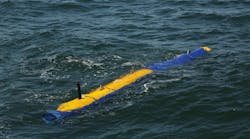L-3 to provide cargo-screening equipment for Australian customs service
The L-3 Communications Security and Detection Systems division in New York will provide the Australian customs service with pallet cargo x-ray screening equipment for use at Australian cargo examination facilities. The contract includes delivery, installation, commissioning, and service of two CX-450P pallet systems with dual view capability. The Australian customs service plans to integrate the cargo screening equipment into its security protocol to manage and ensure Australia's borders at Brisbane and Fremantle. The CX-450P pallet system uses dual-view and dual-energy capability technologies that couple high-resolution imaging with the ability to discriminate varying materials. This allows screeners to qualify organic and inorganic matter, aiding in detection of illegal drugs, firearms, or other contraband. The CX-450 platform is a customizable, high-energy cargo-screening system available as a pallet, vehicle, or gantry configuration. The system can process as many as 34 containers per hour depending upon the configuration. The CX-450P is guaranteed to penetrate 3.5 to 4.0 inches of steel while providing distinguishable images, company officials claim.
EPA awards RAE Systems
Officials at the U.S. Environmental Protection Agency (EPA) in Washington have selected chemical detection technology from RAE Systems in Sunnyvale, Calif., for use in environmental protection and remediation activities. EPA selected RAE Systems' AreaRAE, toxic gas, and Rapid Deployment kits for the five-year contract. This technology will enable EPA personnel to detect and identify, in real time, hazardous gases and volatile chemicals from a remote location. The EPA is already using AreaRAEs to monitor incidents and to prevent injury. The AreaRAE Rapid Deployment Kit (RDK) is designed for quick assessment and management of gaseous threats. The kit includes four wireless, five-gas AreaRAE monitors with in-case charging and a Host Controller to provide remote monitoring from a command center that can be located as far as two miles away. The AreaRAE can detect gaseous volatile organic compounds (VOCs), lower explosive limit (LEL), oxygen level (O2), hydrogen sulfide (H2S), and carbon monoxide (CO), or as many as nine other specific toxic threats including ammonia and chlorine. For more information go online at www.raesystems.com.
DHS approves use of preparedness funds for first responder training courses
Officials at the Department of Homeland Security's (DHS) Office of State and Local Government Coordination and Preparedness (SLGCP), in cooperation with the Department's United States Fire Administration (USFA), recently announced the approval of additional preparedness training courses for emergency responders. The newly approved courses, offered by USFA and the National Fire Academy, include Introduction to Unified Command for Multi-Agency and Catastrophic Incidents, All Hazards Incident Management, and Command and General Staff Functions in the Incident Command System. With this approval, states and urban areas can use allocated Homeland Security Grant Program (HSGP) and Urban Area Security Initiative (UASI) funding to conduct or attend these courses. The HSGP and UASI funding constitutes $6 billion of the total $8 billion in funding allocated or awarded by DHS to state and local governments and first responders since its creation last spring.


